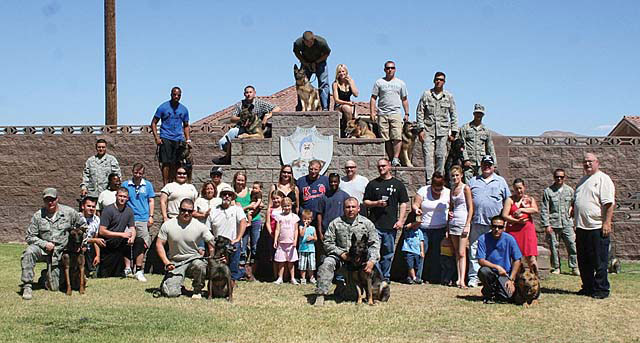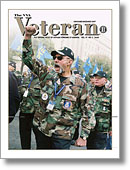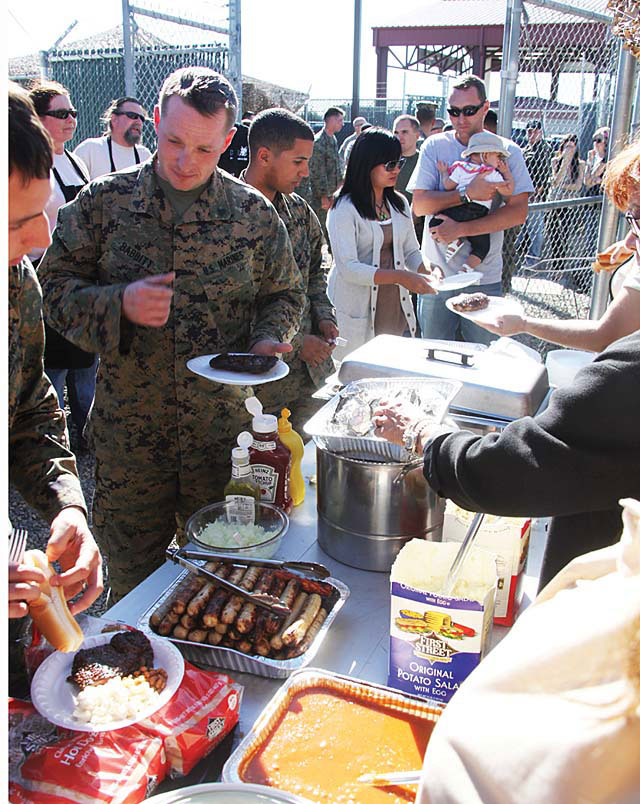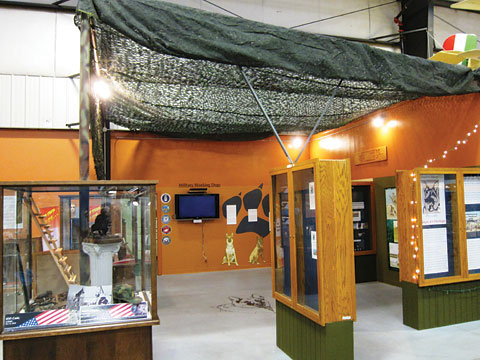 |
|||||||||||
|
May/June 2013
Every Dawg Has His Day: BY XANDE ANDERER Jon Hemp claims he’s not a “joiner.” The first forty years after his return from Vietnam in August 1969 bore this out. In fact, he’d avoided anything remotely veteran related until his “begrudging participation” in his unit’s first reunion in Washington, D.C., during the 25th anniversary of the dedication of The Wall in 2007. That’s when his whole philosophy changed.
“I walked away from that parade with a burr in my butt. I felt like I had to do something significant,” says Hemp. “At first I thought I’d just volunteer at the local VA, push a wheelchair or something.” Then in March 2008 the former dog handler was invited to a barbeque at the Provost Marshal’s Kennel at Camp Pendleton, California, organized by old friends. The event proved to be another turning point. Here he was, being recognized for his own service while creating bonds with a new generation of dog handlers. But something didn’t sit well: “I was enjoying what we were doing, and I didn’t want to insult my buddies, but the idea of serving a hot dog to a Marine just seemed wrong,” Hemp explains. “We needed to do something better for these guys. If we were going to bother doing this, we needed to be throwing steaks down them.” He left the picnic with an embryonic plan to sell t-shirts in order to raise money for better chow. Hemp eventually convinced his friends to form the Feed the Dawgs Project (the Dawgs Project, for short) to raise money for the type of recognition and appreciation barbeques he felt these servicemen and women and their families deserved. They held their first at the Military Working Dog Kennels (MWD) at Camp Pendleton in 2009. They would hold similar barbeques at thirteen other kennels that year. The number has grown every year since. To date, the Project has served meals to active duty military dog handlers, kennel masters, trainers, veterinarians, vet technicians, and their families at twenty-two camps, forts, bases, and ports throughout the U.S. They’ve served over four thousand pounds of steak alone since that first barbeque four years ago, along with an incalculable amount of beans, potatoes, macaroni salad, corn on the cob, watermelon, and soda. All finished off with a dizzying assortment of desserts.
“The folks at Chapter 47 solved a major problem for a fledgling project,” Hemp says. “They bailed us out at the exact moment we were struggling most to get off the ground. Their show of support was crucial.” Hemp estimates it costs between $5,000 and $7,000 a year to continue the mission at the pace they are on. But fundraising for something with such a narrow appeal is a struggle. “It’s surprising how few people care about these guys,” he laments. “Our support comes almost entirely from Vietnam veterans. We’re not high up on any corporation’s gift list. Our ‘market,’ so to speak, is a small one. If we were feeding every G.I. we could find, then I’m sure it’d be entirely different. But we’re old dawgs, and these kids are who we care about most.” Even the leadership of the Feed the Dawgs Project is somewhat unorthodox. It’s steered by an informal committee consisting of four Vietnam veteran dog handlers, a Vietnam veteran parachute packer, an Army parent, and six active-duty service members from a mix of branches. Each committee member has an equal voice, and decisions are made by simple majority vote. There are no officers, no director, no president. The group decided at its outset it would never become a charity in the legal sense. They opted not to seek 501(c)3 status out of fear that politics would distract from their mission. “We all knew of charities that were started with the best of intentions, became a 501(c)3, then lost their ability to do what they set out to do because of politics and finances,” says Hemp. As the Dawgs Project grows in strength, it also grows in scope. The group has taken on the mission to preserve the educational and historical legacy of war dogs and military dog handlers. So, in addition to the barbeques, the project now also sponsors the Military K9 Heritage Exhibit housed at the Field Air Museum at March Air Reserve Base in Riverside, California. The display consisted of a single display case and a mannequin with a missing arm when the Dawgs Project agreed to take it over in October 2009. Now, alongside the military aircraft and aviation artifacts on display at the museum, sits an exhibit of more than 600 square feet of K9 history and memorabilia from World War I to present. It’s regarded by many as the best collection of war dog items anywhere. It has more K9 memorabilia than the Smithsonian’s collection.
The final part of the project’s three-tiered mission is to support overseas military kennels with much-needed—and often scarce—equipment. “Every calendar year we adopt a new kennel to show the guys there they are not forgotten, no matter where they are serving,” says Hemp. In 2009-10 the Dawgs Project adopted the USAF kennels at Kunsan Air Base in South Korea. In 2011 it was Osan Air Base, also in Korea. The project adopted the U.S. Navy kennels at Guantanamo Bay for 2012, and this year will be supporting K9 personnel at the U.S. Naval Expeditionary Base at Camp Lemonnier in Djibouti. Additionally, the Project has supplied critical equipment to Marine dog handlers in Okinawa. “We send tools, leashes, and other specialty equipment these guys can’t get through the normal, sadly overburdened supply chain,” says Hemp. “When I walked the dog in Vietnam, everyone knew if you couldn’t get it through conventional channels, you asked a dog handler.” So this role of “go-to guy” is a natural one for old dawgs. “But we also send as many goodie packs downrange as we can afford,” he says. Care packages of food, clothing, tools, candy, popcorn, and coffee are provided for the personnel stationed at the adopted bases in what project members have dubbed Operation Distraction. “We just want them to know there is someone looking out for them—a sympathetic ear who knows the kinds of things they’re struggling with.” In 2011 the Dawgs Project also adopted the Wounded Warrior detachment at the USMC Air Ground Combat Center at Twentynine Palms, California. The Project donated exercise equipment, bicycles, and personal medical care equipment for all Marines assigned to the unit—not only injured K9 personnel. Hemp’s transformation has been profound: From disinterested bystander he quickly has become a tireless evangelist. “When I was a sentry dog handler we were known for our impatient, independent attitude. [Dog handlers] don’t have a commander, really. It’s just you and your pooch: One dog, one handler, forty acres,” says Hemp. “This project is really just the same thing. “I walked three dogs on three continents during my time in the military: stateside, Libya, and Vietnam. I’m pretty certain that’s unusual.” What’s not unusual is Jon Hemp’s motivation for doing all this: “I just want to make sure these kids never have to come home the way Vietnam veterans did,” he says. It’s that universal theme among Vietnam veterans: I’m not going to let happen to them what happened to me. “I was a sentry dog handler throughout my time in the military. Now there is no such thing,” he remarks. “We were essentially the night vision back then.” Now, with the advances in night vision technology, the mission of military K9s has evolved into many different specialties. Ironically, even with talk of new technologies that could perform some of the same functions, the role of military dogs has done nothing but grow. But for the current crop of military dog handlers gathering to share a meal with some old dawgs, it’s brotherhood all the same. And so is their often under-appreciated job: protecting the lives of American servicemen and women. “Because of what they do, it’s not unusual for these guys to have four or five trips downrange,” says Hemp. “We just want these guys to come home to someone who appreciates the work they are doing. They are America’s front-line defenders.” Maybe Jon Hemp is a joiner after all.
|
|||||||||||
|
|
|||||||||||
8719 Colesville Road, Suite 100, Silver Spring. MD 20910 | www.vva.org | contact us |
|||||||||||










 The funds for the first fourteen picnics came primarily from the pockets of Hemp and the other project founders. As part of a tour to raise awareness and funds for the new project, they attended a 2009 meeting of VVA’s Inland Empire Chapter 47 in Riverside, California, with t-shirts in hand to sell. However, by the time the meeting was adjourned, VVA members had passed the hat and raised enough money to fund the next two events.
The funds for the first fourteen picnics came primarily from the pockets of Hemp and the other project founders. As part of a tour to raise awareness and funds for the new project, they attended a 2009 meeting of VVA’s Inland Empire Chapter 47 in Riverside, California, with t-shirts in hand to sell. However, by the time the meeting was adjourned, VVA members had passed the hat and raised enough money to fund the next two events. 